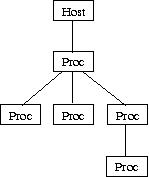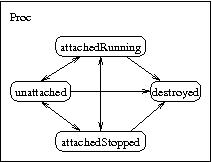
|
||||||||||
| PREV PACKAGE NEXT PACKAGE | FRAMES NO FRAMES | |||||||||
See:
Description
| Interface Summary | |
|---|---|
| FindProc | Interface to be used with Host.requestFindProc. |
| HostRefreshBuilder | [Re-]build the information on the processes running on a host. |
| Observer | Root Observer interface. |
| ProcBlockObserver | An interface perform a one time check of all tasks while each is in the blocked state. |
| ProcTasksObserver | An interface for clients to correctly know about all tasks of a Proc. |
| TaskAttachedObserverXXX | Interface used to notify of a Task that has has been attached, and is about to resume execution in that state. |
| TaskObserver | Observable events generated by a Task. |
| TaskObserver.Cloned | Interface used to notify of Task clone events. |
| TaskObserver.Code | Interface used to notify of a Task that the task's execution has reached a specific point in the code address space. |
| TaskObserver.Execed | Interface used to notify of a Task exec (overlaying the process image with that of a new program). |
| TaskObserver.Forked | Interface used to notify of Task forked (creating a new child process that contains one Task) events. |
| TaskObserver.Instruction | Interface used to notify that a Task has executed a single instruction. |
| TaskObserver.Signaled | Interface used to notify that a Task has a pending signal. |
| TaskObserver.Syscalls | Interface used to notify of a Task either entering, or exiting a system call. |
| TaskObserver.Terminated | Interface used to notify that Task has terminated (the task no longer exits). |
| TaskObserver.Terminating | Interface used to notify of a Task that is terminating. |
| TaskObserver.Watch | |
| Class Summary | |
|---|---|
| Action | An Observer return this Action to indicate what should
happen next. |
| Auxv | |
| Environ | The environment vector. |
| Host | A host machine. |
| HostEvent | Possible host events. |
| Manager | Manager of all operations within the proc model. |
| MemoryMap | Represent a memory map as modelled in /proc/$$/maps. |
| Observable | Observable element of the proc model. |
| Observation | The binding between an Observer and its Observable. |
| Proc | A UNIX Process, containing tasks, memory, ... |
| ProcBlockAction | This class blocks all of the threads in a process and performs a given action defined by the method existingTask(Task task) on each task. |
| ProcEvent | |
| ProcEventObservable | |
| ProcTasksAction | Provides a mechanism for tracing all clone events within a process. |
| StressAttachDetachManyTasks | Test attaching to a process with many many tasks. |
| StressAttachDetachRapidlyCloningMainTask | Observer stress test. |
| StressAttachDetachRapidlyForkingMainTask | Check that the observer TaskObserver.Forked works. |
| StressAttachDetachSignaledTask | Test attaching to a process with many many tasks. |
| StressAttachDetachSignaledTask.SignalStorm | A signal class; that just adds then delets itself. |
| StressTestAbandon | |
| Task | |
| TaskEvent | |
| TaskId | Light weight identifier for a task. |
| TestAbandon | |
| TestBreakpoints | |
| TestBreakpoints.InstructionObserver | |
| TestComparable | |
| TestEnviron | Test an Environment vector. |
| TestExec | Test the exec event. |
| TestFindProc | |
| TestHostGet | Test Host's public get methods. |
| TestInstructions | |
| TestInstructions.InstructionObserver | |
| TestInstructions.Symbol | |
| TestMapGet | |
| TestProcForceDetach | |
| TestProcGet | Test Proc's public get methods. |
| TestProcTasksObserver | Test that the Proc's ProcTasks Observer correctly reports the tasks belonging to a process. |
| TestProcTasksObserver.ProcTasksTester | |
| TestRun | Check that a program can be run to completion. |
| TestSyscallRunning | XXX: This code should be simplified, eliminating local parallelism by performing everything in a single test-thread. |
| TestSyscallSignal | XXX: This code should be simplified, eliminating local parallelism by performing everything in a single test-thread. |
| TestTaskClonedObserver | Check that clone (task create and delete) events are detected. |
| TestTaskForkedObserver | Check that the observer TaskObserver.Forked works. |
| TestTaskObserver | Generic observer tests - that the framework functions ok. |
| TestTaskObserverDetach | Check that random events, arriving mid-way through a detach, are handled. |
| TestTaskObserverInstruction | |
| TestTaskObserverInstruction.InstructionObserver | |
| TestTaskObserverInstructionAndCode | |
| TestTaskObserverInstructionAndCode.CodeObserver | |
| TestTaskObserverInstructionAndCode.InstructionObserver | |
| TestTaskObserverInstructionAndCode.TerminatedObserver | |
| TestTaskObserverInstructionAndCode.TestObserver | |
| TestTaskObserverInstructionSigReturn | |
| TestTaskObserverWatchpoint | |
| TestTaskObserverWatchpoint.AddFailWatchObserver | |
| TestTaskObserverWatchpoint.CodeObserver | |
| TestTaskObserverWatchpoint.FailingWatchObserver | |
| TestTaskObserverWatchpoint.InstructionObserver | |
| TestTaskObserverWatchpoint.OkToTerminateObserver | |
| TestTaskObserverWatchpoint.Symbol | |
| TestTaskObserverWatchpoint.TerminatedObserver | |
| TestTaskObserverWatchpoint.TestObserver | |
| TestTaskObserverWatchpoint.WatchObserver | |
| TestTaskSyscallObserver | Check that syscall events are detected. |
| TestTaskSyscallObserver.SyscallObserver | |
| TestTaskTerminateObserver | Check the Task terminating and terminated observers. |
| TestTaskTerminateObserver.TerminatingCounter | |
This package implements frysk's process model of the target system.
Host), processes
(Proc), and tasks (Task, a.k.a., threads).
Frysk provides both behavioral and relational views of that model.
The following sections describe each of those views.

Process 1 forms the root of the process tree.
The tasks, within a process, form a simple two level tree:

Methods for iterating over, and searching for, a host's process and tasks are provided.
The process model can also be viewed as a collection of independent state-machines. Each state-machine instance tracks the state of the corresponding host, process, or task.
For instance, a process(or Proc object) has the
following states:

The client manipulates a state-machine instance by sending it request messages. The state-machine, in turn, notifies interested client of state transitions that result from these requests, and other asynchronous events, using observers.
Finally, the individual state-machine uses internal messages to co-ordinate the systems overall state.
|
||||||||||
| PREV PACKAGE NEXT PACKAGE | FRAMES NO FRAMES | |||||||||